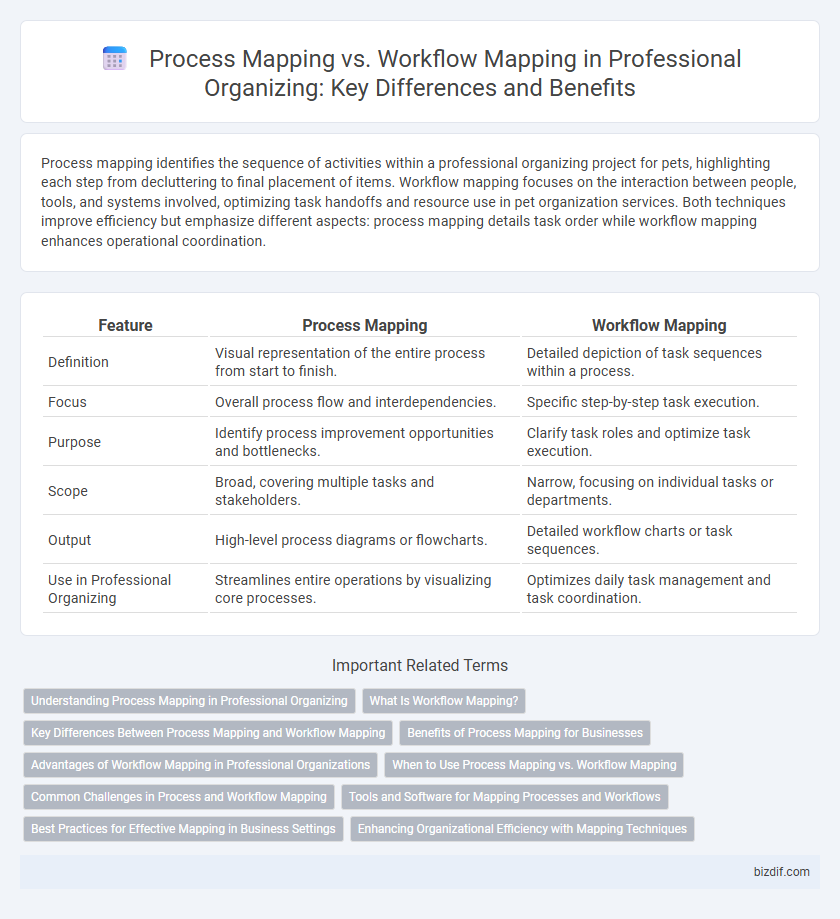Process mapping identifies the sequence of activities within a professional organizing project for pets, highlighting each step from decluttering to final placement of items. Workflow mapping focuses on the interaction between people, tools, and systems involved, optimizing task handoffs and resource use in pet organization services. Both techniques improve efficiency but emphasize different aspects: process mapping details task order while workflow mapping enhances operational coordination.
Table of Comparison
| Feature | Process Mapping | Workflow Mapping |
|---|---|---|
| Definition | Visual representation of the entire process from start to finish. | Detailed depiction of task sequences within a process. |
| Focus | Overall process flow and interdependencies. | Specific step-by-step task execution. |
| Purpose | Identify process improvement opportunities and bottlenecks. | Clarify task roles and optimize task execution. |
| Scope | Broad, covering multiple tasks and stakeholders. | Narrow, focusing on individual tasks or departments. |
| Output | High-level process diagrams or flowcharts. | Detailed workflow charts or task sequences. |
| Use in Professional Organizing | Streamlines entire operations by visualizing core processes. | Optimizes daily task management and task coordination. |
Understanding Process Mapping in Professional Organizing
Process mapping in professional organizing visually represents each step of a task or project to identify inefficiencies and improve productivity. Unlike workflow mapping, which emphasizes the sequence and flow of activities, process mapping provides detailed insights into inputs, outputs, and decision points essential for streamlining organizational systems. This approach helps professional organizers design customized solutions that enhance clarity and optimize time management for clients.
What Is Workflow Mapping?
Workflow mapping visually represents a sequence of tasks or activities that define how work is completed within a process, emphasizing the flow of actions from start to finish. It highlights task dependencies, decision points, and the movement of information or materials to optimize efficiency and reduce bottlenecks. In professional organizing, workflow mapping helps identify redundant steps and streamline operations for smoother project execution.
Key Differences Between Process Mapping and Workflow Mapping
Process mapping provides a detailed visualization of each step within a business process, emphasizing sequence, decision points, and interactions to improve efficiency. Workflow mapping focuses on the tasks' flow and allocation within a work environment, highlighting roles, responsibilities, and communication between team members. The key difference lies in process mapping's broader scope targeting overall process improvement, while workflow mapping zeroes in on task execution and team collaboration within the process.
Benefits of Process Mapping for Businesses
Process mapping provides businesses with a clear visualization of each step within a process, enabling identification of inefficiencies and bottlenecks that hinder productivity. This detailed analysis supports data-driven decision-making, leading to optimized resource allocation and reduced operational costs. Enhanced communication across teams results from standardized documentation, promoting consistency and improved collaboration throughout the organization.
Advantages of Workflow Mapping in Professional Organizations
Workflow mapping enhances professional organizations by visually detailing task sequences, enabling clear identification of bottlenecks and inefficiencies for targeted improvements. It fosters collaboration through transparent communication pathways, ensures consistency in task execution, and supports scalable process optimization. Workflow mapping's dynamic nature allows real-time updates, aligning teams with organizational goals and adapting swiftly to workflow changes.
When to Use Process Mapping vs. Workflow Mapping
Process mapping is ideal for analyzing and improving complex, multi-step operations that involve cross-functional teams, enabling identification of inefficiencies and bottlenecks. Workflow mapping suits repetitive, task-focused sequences within a single department, emphasizing task flow and handoffs to optimize routine procedures. Use process mapping when strategic improvement and high-level visualization are needed, while workflow mapping is best for detailed, operational clarity in straightforward tasks.
Common Challenges in Process and Workflow Mapping
Common challenges in process and workflow mapping include identifying all relevant stakeholders and accurately capturing complex steps, which can lead to incomplete or misleading diagrams. Miscommunication often arises from undefined terms and inconsistent documentation, hindering effective collaboration. Accurate sequencing and integrating dynamic changes remain significant obstacles in maintaining up-to-date and actionable process and workflow maps.
Tools and Software for Mapping Processes and Workflows
Process mapping tools like Microsoft Visio and Lucidchart enable detailed visualization of complex processes with extensive customization and integration options. Workflow mapping software such as Trello and Asana focuses on task management and automation, streamlining repetitive activities and enhancing collaborative execution. Selecting tools with features like drag-and-drop interfaces, customizable templates, and real-time collaboration optimizes the efficiency of professional organizing projects.
Best Practices for Effective Mapping in Business Settings
Process mapping captures the sequence of activities within a business process, highlighting each step's inputs, outputs, and decision points to identify inefficiencies and areas for improvement. Workflow mapping focuses on task progression, roles, and communication flow to ensure smooth handoffs and reduce bottlenecks in daily operations. Best practices include involving cross-functional teams for accurate data, using standardized symbols for clarity, and continuously updating maps to reflect changes in business processes.
Enhancing Organizational Efficiency with Mapping Techniques
Process mapping visually outlines each step in a business operation to identify inefficiencies and streamline tasks, enhancing organizational efficiency through clear, detailed analysis. Workflow mapping focuses on the sequential flow of tasks and decision points, optimizing time management and resource allocation within projects. Leveraging both techniques provides comprehensive insights, enabling professionals to reorganize structures and boost productivity effectively.
process mapping vs workflow mapping Infographic

 bizdif.com
bizdif.com